Logitech 2012 Annual Report Download - page 235
Download and view the complete annual report
Please find page 235 of the 2012 Logitech annual report below. You can navigate through the pages in the report by either clicking on the pages listed below, or by using the keyword search tool below to find specific information within the annual report.-
 1
1 -
 2
2 -
 3
3 -
 4
4 -
 5
5 -
 6
6 -
 7
7 -
 8
8 -
 9
9 -
 10
10 -
 11
11 -
 12
12 -
 13
13 -
 14
14 -
 15
15 -
 16
16 -
 17
17 -
 18
18 -
 19
19 -
 20
20 -
 21
21 -
 22
22 -
 23
23 -
 24
24 -
 25
25 -
 26
26 -
 27
27 -
 28
28 -
 29
29 -
 30
30 -
 31
31 -
 32
32 -
 33
33 -
 34
34 -
 35
35 -
 36
36 -
 37
37 -
 38
38 -
 39
39 -
 40
40 -
 41
41 -
 42
42 -
 43
43 -
 44
44 -
 45
45 -
 46
46 -
 47
47 -
 48
48 -
 49
49 -
 50
50 -
 51
51 -
 52
52 -
 53
53 -
 54
54 -
 55
55 -
 56
56 -
 57
57 -
 58
58 -
 59
59 -
 60
60 -
 61
61 -
 62
62 -
 63
63 -
 64
64 -
 65
65 -
 66
66 -
 67
67 -
 68
68 -
 69
69 -
 70
70 -
 71
71 -
 72
72 -
 73
73 -
 74
74 -
 75
75 -
 76
76 -
 77
77 -
 78
78 -
 79
79 -
 80
80 -
 81
81 -
 82
82 -
 83
83 -
 84
84 -
 85
85 -
 86
86 -
 87
87 -
 88
88 -
 89
89 -
 90
90 -
 91
91 -
 92
92 -
 93
93 -
 94
94 -
 95
95 -
 96
96 -
 97
97 -
 98
98 -
 99
99 -
 100
100 -
 101
101 -
 102
102 -
 103
103 -
 104
104 -
 105
105 -
 106
106 -
 107
107 -
 108
108 -
 109
109 -
 110
110 -
 111
111 -
 112
112 -
 113
113 -
 114
114 -
 115
115 -
 116
116 -
 117
117 -
 118
118 -
 119
119 -
 120
120 -
 121
121 -
 122
122 -
 123
123 -
 124
124 -
 125
125 -
 126
126 -
 127
127 -
 128
128 -
 129
129 -
 130
130 -
 131
131 -
 132
132 -
 133
133 -
 134
134 -
 135
135 -
 136
136 -
 137
137 -
 138
138 -
 139
139 -
 140
140 -
 141
141 -
 142
142 -
 143
143 -
 144
144 -
 145
145 -
 146
146 -
 147
147 -
 148
148 -
 149
149 -
 150
150 -
 151
151 -
 152
152 -
 153
153 -
 154
154 -
 155
155 -
 156
156 -
 157
157 -
 158
158 -
 159
159 -
 160
160 -
 161
161 -
 162
162 -
 163
163 -
 164
164 -
 165
165 -
 166
166 -
 167
167 -
 168
168 -
 169
169 -
 170
170 -
 171
171 -
 172
172 -
 173
173 -
 174
174 -
 175
175 -
 176
176 -
 177
177 -
 178
178 -
 179
179 -
 180
180 -
 181
181 -
 182
182 -
 183
183 -
 184
184 -
 185
185 -
 186
186 -
 187
187 -
 188
188 -
 189
189 -
 190
190 -
 191
191 -
 192
192 -
 193
193 -
 194
194 -
 195
195 -
 196
196 -
 197
197 -
 198
198 -
 199
199 -
 200
200 -
 201
201 -
 202
202 -
 203
203 -
 204
204 -
 205
205 -
 206
206 -
 207
207 -
 208
208 -
 209
209 -
 210
210 -
 211
211 -
 212
212 -
 213
213 -
 214
214 -
 215
215 -
 216
216 -
 217
217 -
 218
218 -
 219
219 -
 220
220 -
 221
221 -
 222
222 -
 223
223 -
 224
224 -
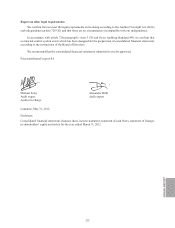 225
225 -
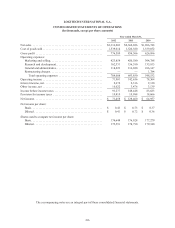 226
226 -
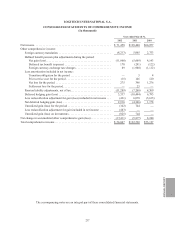 227
227 -
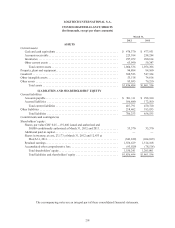 228
228 -
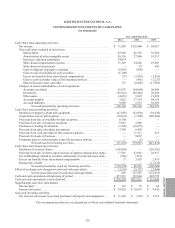 229
229 -
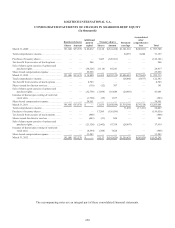 230
230 -
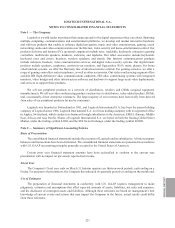 231
231 -
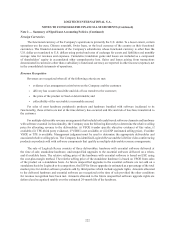 232
232 -
 233
233 -
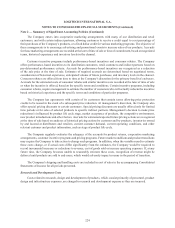 234
234 -
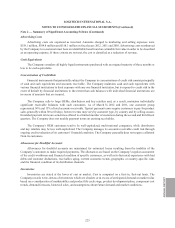 235
235 -
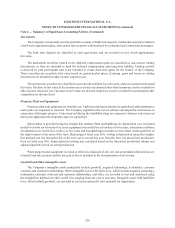 236
236 -
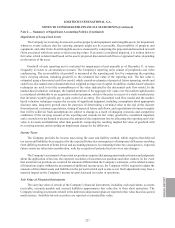 237
237 -
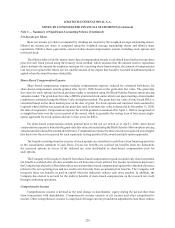 238
238 -
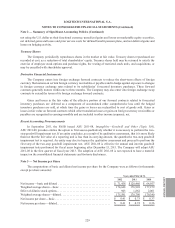 239
239 -
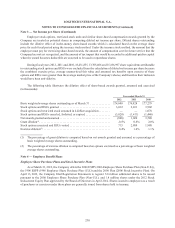 240
240 -
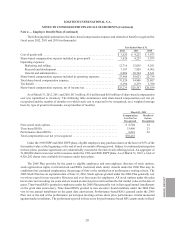 241
241 -
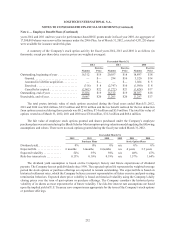 242
242 -
 243
243 -
 244
244 -
 245
245 -
 246
246 -
 247
247 -
 248
248 -
 249
249 -
 250
250 -
 251
251 -
 252
252 -
 253
253 -
 254
254 -
 255
255 -
 256
256 -
 257
257 -
 258
258 -
 259
259 -
 260
260 -
 261
261 -
 262
262 -
 263
263 -
 264
264 -
 265
265 -
 266
266 -
 267
267 -
 268
268 -
 269
269 -
 270
270 -
 271
271 -
 272
272 -
 273
273 -
 274
274 -
 275
275 -
 276
276 -
 277
277 -
 278
278 -
 279
279 -
 280
280 -
 281
281 -
 282
282 -
 283
283 -
 284
284 -
 285
285 -
 286
286 -
 287
287 -
 288
288 -
 289
289 -
 290
290 -
 291
291 -
 292
292
 |
 |

LOGITECH INTERNATIONAL S.A.
NOTES TO CONSOLIDATED FINANCIAL STATEMENTS (Continued)
Advertising Costs
Advertising costs are expensed as incurred. Amounts charged to marketing and selling expenses were
$158.1 million, $184.8 million and $118.1 million in fiscal years 2012, 2011 and 2010. Advertising costs reimbursed
by the Company to a customer must have an identifiable benefit and an estimable fair value in order to be classified
as an operating expense. If these criteria are not met, the cost is classified as a reduction of revenue.
Cash Equivalents
The Company considers all highly liquid instruments purchased with an original maturity of three months or
less to be cash equivalents.
Concentration of Credit Risk
Financial instruments that potentially subject the Company to concentrations of credit risk consist principally
of cash and cash equivalents and accounts receivable. The Company maintains cash and cash equivalents with
various financial institutions to limit exposure with any one financial institution, but is exposed to credit risk in the
event of default by financial institutions to the extent that cash balances with individual financial institutions are
in excess of amounts that are insured.
The Company sells to large OEMs, distributors and key retailers and, as a result, maintains individually
significant receivable balances with such customers. As of March 31, 2012 and 2011, one customer group
represented 14% and 13% of total accounts receivable. Typical payment terms require customers to pay for product
sales generally within 30 to 60 days; however terms may vary by customer type, by country and by selling season.
Extended payment terms are sometimes offered to a limited number of customers during the second and third fiscal
quarters. The Company does not modify payment terms on existing receivables.
The Company’s OEM customers tend to be well-capitalized, multi-national companies, while distributors
and key retailers may be less well-capitalized. The Company manages its accounts receivable credit risk through
ongoing credit evaluation of its customers’ financial condition. The Company generally does not require collateral
from its customers.
Allowances for Doubtful Accounts
Allowances for doubtful accounts are maintained for estimated losses resulting from the inability of the
Company’s customers to make required payments. The allowances are based on the Company’s regular assessment
of the credit worthiness and financial condition of specific customers, as well as its historical experience with bad
debts and customer deductions, receivables aging, current economic trends, geographic or country-specific risks
and the financial condition of its distribution channels.
Inventories
Inventories are stated at the lower of cost or market. Cost is computed on a first-in, first-out basis. The
Company records write-downs of inventories which are obsolete or in excess of anticipated demand or market value
based on a consideration of marketability and product life cycle stage, product development plans, component cost
trends, demand forecasts, historical sales, and assumptions about future demand and market conditions.
Note 2 — Summary of Significant Accounting Policies (Continued)
ANNUAL REPORT
225
